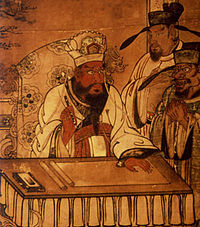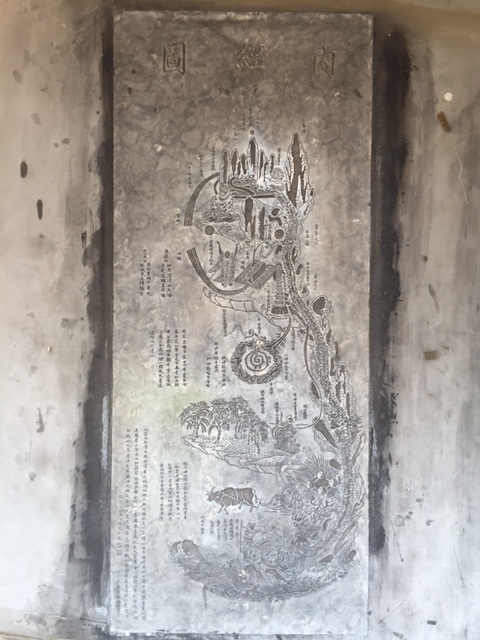By all accounts, this August was an uncomfortable one here in Northern New Jersey. It was fairly wet and rainy, and it was hot. All combined together, the humidity was oppressive, and all the moisture means mosquitoes everywhere! However, just on time, last night a high pressure system from Canada moved down into the northeastern US and the temperatures dipped into the low 60s overnight. Cooler and drier weather made sleeping much nicer, and it looks like the trend of cooler evenings will continue for at least a little longer. The reason I say this happened just on time is that today is the start of the first Seasonal Node after the beginning of Autumn – Chu Shu 處暑, ‘End of Heat’.
Autumn is the time of year when Yin grows. All things are moving towards the hibernation phase and many plants are being readied for harvest. The names of the smaller 5-day periods of this seasonal node are quite interesting and illustrative of what Autumn represents. The first is called Ying Nai Ji Niao 鷹乃祭鳥, Hawks Start to Sacrifice Birds. This time of year starts the slow march towards the death phase of nature, and many plants and animals with short life spans won’t make it to next Spring. The image of hawks harvesting or killing smaller birds then fits perfectly with this image. The next two 5-day time periods are Tian Di Shi Su 天地始肅, Heaven and Earth Become Austere, and He Nai Deng 禾乃登, Rice Plants Are Harvested and Presented as Offering. Just as this is the time of year for bringing things to harvest, it is also the time for us to start becoming quieter and more introspective, for us to take stock of what, out of the myriad things in our lives, is really important (i.e., we become austere like heaven and earth).
In more tangible respects there are things to keep in mind to maintain health this time of year. The first traditional recommendation for Chu Shu is Ben Franklin’s favorite – ‘early to bed, early to rise’ (zao shui zao qi 早睡早起). When Yin predominates in the natural environment we can mimic that in our own body by getting more sleep. In the summer it is permissible to stay up later and still wake up early. In the Yang time of year less sleep is just fine. However, now that Autumn (a Yin season) is upon us, we need to get a little more rest. My general recommendation to patients is to get into bed a bit earlier, preferably before 11pm or midnight. Here’s a little quiz for other Chinese medicine providers – why is it important to get to bed before this hour? (Hint – it isn’t because of the Liver hour just afterwards)
The weather pattern associated with Autumn is dryness and thus another caution during Autumn is not becoming too dry (although right now as I write this in NJ that seems like an unlikely scenario). One way we do this is through diet; now is the time to focus on shao xin, zeng suan 少辛增酸 – ‘less spicy, more sour’. Spicy flavors have a mild drying quality as well as a sweat promoting quality, both of which dry the body. To the contrary, sour foods are gently moistening and hold in sweat. Increasing the amount of foods such as vinegar, pickled vegetables, and fruits such as plums is appropriate to the season. Other moistening foods include milk, soymilk, and fruit juices (especially apple or pear). This recommendation should be taken less seriously for those with very damp constitutions or presentations.
One traditional recipe for this season is Pear and White Wood Ear Soup. This dish is just simply delicious, and it is effective for supplementing the Lungs, nourishing fluids, and moistening dryness (without being so cloying as to create dampness).
Pear and White Wood Ear Soup 雪梨銀耳湯
Ingredients:
- 1 large Asian pear 雪梨
- 2 dried white wood ear mushrooms 銀耳
- 1 small fresh edible lily bulb 百合
- About ½ cup white or rock sugar
Directions:
- Soak wood ear for about 30 minutes, until softened
- Rip wood ears into bite sized pieces, peel and cut pear into medium bite sized chunks, and separate out lily bulb into individual corms
- In a pot, put about 6 cups of water together with all ingredients; bring to boil and simmer for 30minutes to 2 hours on a very low heat
For those who like wood ears crisper, go for the shorter simmer time. For those who like things softer and more gelatinous, cook longer. My suggestion is to take small tastes along the way. This soup can be served warm or chilled (depending on preference and outside temperature).
The last recommendation I’ll offer is for those patients who continue to experience symptoms of damp, heat, or the combination thereof in the form of summerheat. A traditional channel based recommendation for Chu Shu is regular acupressure on Cheng Shan BL-57. This point helps expel damp and clear heat, and treats many symptoms of lingering summerheat such as headache, body aches, heavy limbs, or diarrhea. Notice that this area of the leg is one of thick flesh, and remember that the seventh chapter of the Ling Shu describes a needling method based on the five tissues and their relationships to the five viscera. One of the passages from that chapter reads:
四曰合谷刺,合谷刺者,左右雞足,針於分肉之間,以取肌痺,此脾之應也
The fourth is called united valleys piercing. United valleys piercing is to pierce left then right from the same hole, like a chicken's foot. Pierce to the division between the flesh. This treats flesh block (bi). It is in resonance with the Spleen.
Here we see that needling into fleshy areas of the body treats problems of the flesh as well as treats problems of the Spleen. As dampness is the disease evil of the Earth phase (and thus the Spleen), this needling technique also has resonance with its treatment. For example, over the last few weeks, patients in my office have been complaining of aching and heaviness in the joints, especially of the knees, hips and in general lower extremities. This is because dampness, as a Yin disease evil, commonly moves down in the body. One of the points I’ve been using over and over again to work with this is Jian Zhong 44.06. The point, located on the shoulder, is in a fleshy area of the body just like Cheng Shan BL-57 is. Likewise, it treats damp accumulation of the joints and extremities. Other points in the shoulder area, such as Bei Mian 44.07, are specifically indicated for digestive problems such as abdominal distension, vomiting or enteritis. This is because, like Jian Zhong 44.06 and Cheng Shan BL-57, Bei Mian is in an area of thick flesh and thus treats problems of the Spleen. This time of year as we are still experiencing summerheat and dampness, these types of points can be frequently used.










